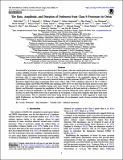Por favor, use este identificador para citar o enlazar a este item:
http://hdl.handle.net/10261/271549COMPARTIR / EXPORTAR:
 SHARE SHARE
 CORE
BASE CORE
BASE
|
|
| Visualizar otros formatos: MARC | Dublin Core | RDF | ORE | MODS | METS | DIDL | DATACITE | |

| Título: | The Rate, Amplitude, and Duration of Outbursts from Class 0 Protostars in Orion |
Autor: | Zakri, Wafa; Megeath, S. Thomas; Fischer, William J.; Gutermuth, Robert; Furlan, Elise; Hartmann, Lee; Karnath, Nicole; Osorio, Mayra CSIC ORCID; Safron, Emily; Stanke, Thomas; Stutz, Amelia M.; Tobin, John J.; Allen, Thomas S.; Federman, Sam; Habel, Nolan; Manoj, P.; Narang, Mayank; Pokhrel, Riwaj; Rebull, Luisa; Sheehan, Patrick D.; Watson, Dan M. | Palabras clave: | Protostars Star formation Variable stars Infrared astronomy |
Fecha de publicación: | 12-ene-2022 | Editor: | IOP Publishing | Citación: | Astrophysical Journal Letters 924(2): L23 (2022) | Resumen: | At least half of a protostar's mass is accreted in the Class 0 phase, when the central protostar is deeply embedded in a dense, infalling envelope. We present the first systematic search for outbursts from Class 0 protostars in the Orion clouds. Using photometry from Spitzer/IRAC spanning 2004 to 2017, we detect three outbursts from Class 0 protostars with ≥2 mag changes at 3.6 or 4.5 μm. This is comparable to the magnitude change of a known protostellar FU Ori outburst. Two are newly detected bursts from the protostars HOPS 12 and 124. The number of detections implies that Class 0 protostars burst every 438 yr, with a 95% confidence interval of 161 to 1884 yr. Combining Spitzer and WISE/NEOWISE data spanning 2004–2019, we show that the bursts persist for more than nine years with significant variability during each burst. Finally, we use 19–100 μm photometry from SOFIA, Spitzer, and Herschel to measure the amplitudes of the bursts. Based on the burst interval, a duration of 15 yr, and the range of observed amplitudes, 3%–100% of the mass accretion during the Class 0 phase occurs during bursts. In total, we show that bursts from Class 0 protostars are as frequent, or even more frequent, than those from more evolved protostars. This is consistent with bursts being driven by instabilities in disks triggered by rapid mass infall. Furthermore, we find that bursts may be a significant, if not dominant, mode of mass accretion during the Class 0 phase. © 2022. The Author(s). Published by the American Astronomical Society. | Descripción: | This is an Open Access article distributed under the terms of the Creative Commons Attribution License (http://creativecommons.org/licenses/by/4.0/), which permits unrestricted reuse, distribution, and reproduction in any medium, provided the original work is properly cited. | Versión del editor: | http://dx.doi.org/10.3847/2041-8213/ac46ae | URI: | http://hdl.handle.net/10261/271549 | DOI: | 10.3847/2041-8213/ac46ae | ISSN: | 2041-8205 | E-ISSN: | 2041-8213 |
| Aparece en las colecciones: | (IAA) Artículos |
Ficheros en este ítem:
| Fichero | Descripción | Tamaño | Formato | |
|---|---|---|---|---|
| 2022ApJ_924L_23Z.pdf | 5,18 MB | Adobe PDF |  Visualizar/Abrir |
CORE Recommender
SCOPUSTM
Citations
24
checked on 19-may-2024
WEB OF SCIENCETM
Citations
14
checked on 23-feb-2024
Page view(s)
62
checked on 21-may-2024
Download(s)
31
checked on 21-may-2024
Google ScholarTM
Check
Altmetric
Altmetric
Este item está licenciado bajo una Licencia Creative Commons

